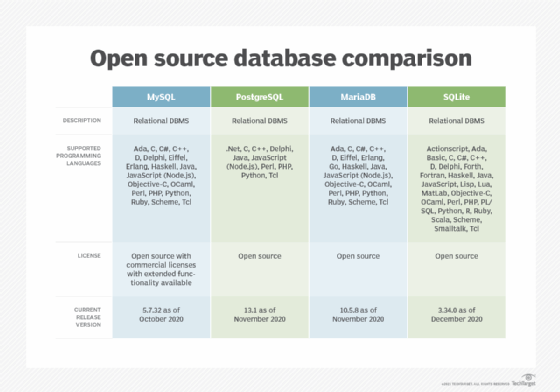What is MySQL?
MySQL is a popular, scalable, user-friendly, open source and free relational database management system (RDBMS) that uses Structured Query Language (SQL) to store, manage and manipulate data.
Well-known for its high speed, performance and reliability, MySQL is operating system (OS)-agnostic so it runs seamlessly on numerous platforms, including Linux, UNIX, macOS and Windows. MySQL can be used to support a wide range of applications, but it is most often associated with web applications and online publishing (websites and blogs).
What is MySQL used for?
Today, MySQL is a very popular RDBMS choice with both web developers and web-based organizations. Many of the top websites in the world and countless corporate and consumer-facing web applications use MySQL, including:
MySQL is a particularly popular choice with websites using the .com domain.
Many content management systems (CMS) are also based on MySQL, including the following:
- WordPress.com.
- WordPress.org.
- Drupal.
- Joomla.
- Contao.
- TYPO3.
- MODx.
Other web applications and sites that use MySQL include the following:
- URL shortening and link management services like Bitly.
- Demand-side platforms (DSP) like Zemanta.
- Microblogging platforms like Tumblr.
- Online avatar creation sites like Gravatar.
- Forum creation software like phpBB and MyBB.
- E-commerce platforms like Shopify, WooCommerce and BigCommerce.
MySQL is also commonly used as an embedded database for many software and hardware products.
How MySQL works
MySQL is based on a client-server model, with a multithreaded server supporting multiple clients and fulfilling requests from them. The core of MySQL is MySQL server, which handles all of the database instructions (or commands). MySQL server is used for storing, organizing and managing data. Users can interact with MySQL server to submit queries and find data. MySQL server is available as a separate (standalone) program for use in a client-server networked environment and as a multithreaded library that can be embedded (or linked) into separate applications.
MySQL operates along with several utility programs that support the administration of MySQL databases. Commands are sent to MySQL server via the MySQL client, which is installed on a computer. It is the MySQL client that queries the MySQL server to find the specified data.
MySQL was originally developed to handle large databases quickly. Although MySQL is typically installed on only one machine, it is able to send the database to multiple locations, and users are able to access it via different MySQL client graphical user interfaces. These interfaces send SQL statements or requests to the server, extract data from the database and then display the results.
Core MySQL features
MySQL is a free and open source RDBMS, so anyone can modify and distribute it under the GNU General Public License (GPL). It is a relational database, meaning it organizes data points with defined relationships and stores data in tables of rows and columns which are defined by schemas. This structural approach makes it easy to organize and find different types of information in the database, such as text, numbers and dates.
MySQL enables data to be stored and accessed across multiple storage engines, including InnoDB, cluster shared volumes (CSV) and NDB (NDB Cluster). This provides greater flexibility and freedom in use. MySQL is also capable of replicating data and partitioning tables for better performance and durability. MySQL users aren't required to learn new commands; they can access their data using standard SQL commands.

MySQL is written in C and C++ and is available across over 20 platforms, including Mac, Windows, Linux and Unix. The RDBMS supports large databases with millions of records and supports many data types including signed or unsigned integers 1, 2, 3, 4 and 8 bytes long; FLOAT; DOUBLE; CHAR; VARCHAR; BINARY; VARBINARY; TEXT; BLOB; DATE; TIME; DATETIME; TIMESTAMP; YEAR; SET; ENUM; and OpenGIS spatial types. Fixed- and variable-length string types are also supported.
MySQL supports a wide variety of application programming interfaces (APIs). The APIs can link data to different back ends, programs, libraries and administrative tools in different programming languages to the MySQL server. Supported languages include Java, Python, JavaScript, C++, C# and PHP.
For security, MySQL uses an access privilege and encrypted password system that enables host-based verification. MySQL clients can connect to MySQL server using several protocols, including TCP/IP sockets on any platform. MySQL also supports a number of client and utility programs, command-line programs and administration tools such as MySQL Workbench. Other security features include data encryption, data masking, secure storage and a database firewall to further strengthen data protection and also facilitate compliance with privacy laws and regulations like the General Data Protection Regulation (GDPR), Health Insurance Portability and Accountability Act (HIPAA) and Payment Card Industry Data Security Standard (PCI-DSS).
MySQL supports ACID (atomicity, consistency, isolation and durability) transactions to facilitate dependable and accurate processing of database transactions. These transactions also ensure that the database always remains in a consistent state, even in the event of a system failure.
Another key feature of MySQL is its ability to scale. With built-in features like partitioning and clustering, MySQL can handle large-scale databases and high volumes of concurrent connections (high traffic applications). This is one reason why MySQL is a popular RDBMS choice for large organizations and for many web-based applications where fast, high-volume transactions are the norm, including social media, CMS and e-commerce.
Advantages of MySQL
One of the biggest advantages of MySQL over other RDBMSes is that it is easy to use. As a zero-administration database system, it is very easy to manage. It also installs very quickly, with a typical installation taking just a few minutes from start to end.
MySQL is also a very reliable and scalable database. It is continuously maintained and improved by an active global community and has been tested for a wide variety of scenarios over many years. Also, it is based on a native replication architecture for data redundancy. As a result, MySQL offers consistently high performance for many kinds of web applications, including business-critical and high-traffic applications.
MySQL incorporates numerous native replication technologies to support high availability. Cloud-based MySQL implementations also include built-in disaster recovery features to boost operational resilience and ensure high uptime. Support for ACID transactions ensures data integrity, dependable transaction processing and consistent data modifications.
Flexibility is another important benefit of MySQL. Developers can freely develop traditional SQL and NoSQL schema-free database applications, knowing that they will always work with MySQL. In addition, relational data and JavaScript Object Notation, or JSON, documents can be combined within the same database.
The numerous security features of MySQL help protect data within the database from misuse and unauthorized manipulation. Secure data storage and backup speed up disaster recovery and minimize the potential for data losses in the event of an adverse event.
Finally, MySQL is a cost-effective RDBMS. As an open source product, anyone can download and use MySQL, often without incurring any cost. For example, the MySQL Enterprise Edition for Developers is completely free of cost for learning, developing and prototyping. That said, organizations looking to use MySQL for the purpose of embedding MySQL code into one or more commercial applications can purchase a commercially licensed version like MySQL Enterprise Edition from Oracle.

History of MySQL
Originally conceived by the Swedish company MySQL AB in 1995, MySQL was meant to provide database users with a user-friendly RDBMS software. MySQL AB company was acquired by Sun Microsystems in 2008 and then by Oracle when it bought Sun in 2010. Oracle continues to own MySQL as of 2025.
In 2000, MySQL was released under the GNU GPL, giving users the freedom to run, share, and even modify the software as per their needs. Today, MySQL remains open source and developers can still use it under the GNU GPL. However, for-profit enterprises must obtain a commercial license of MySQL from Oracle. As of 2025, MySQL is the most widely used open source RDBMS, accounting for the highest market share in the relational databases software market, well past many available alternatives like PostgreSQL and Amazon RDS.
Over the years, numerous offshoots of MySQL, also known as forks, have emerged, such as the following:
- MariaDB is a MySQL offshoot designed by the original developers of MySQL to be a drop-in replacement for MySQL offering features like clustering and multithreading for high availability, performance and scalability.
- Percona is an enterprise-grade open source software for MySQL, with built-in backup, observability and troubleshooting tools.
MySQL editions
MySQL is available in several different versions. Users can select the edition they need depending on their requirements and whether they are looking for a commercial (paid) or free product.
MySQL Enterprise Edition
This is the commercial version of MySQL. Suitable for developing, deploying and managing business-critical enterprise MySQL applications, it is highly scalable, secure and reliable, and provides very high levels of performance and uptime. Additionally, it is an ACID-compliant database.
This edition includes numerous management tools and advanced features for MySQL, such as the ones listed below:
- MySQL Enterprise Backup for online data backup and recovery.
- MySQL Enterprise Authentication so organizations can use their existing security infrastructures.
- Security features like data encryption (Transparent Data Encryption and Enterprise Encryption), key generation and digital signatures to protect sensitive data.
- MySQL Enterprise Firewall that blocks database attacks such as SQL injections.
- Support for MySQL InnoDB Cluster and MySQL InnoDB ClusterSet to ensure high database availability.
- Built-in MySQL Enterprise Telemetry to monitor and track MySQL performance.
- MySQL Operator for Kubernetes to help businesses deploy and manage private DBaaS and microservices-based applications.
MySQL Enterprise Edition also includes access to MySQL HeatWave, a cloud-based, fully managed database service that accelerates MySQL query performance. HeatWave combines transactional (OLTP) and analytical (OLAP) workloads, supports lakehouse-scale analytics and provides integrated and automated generative AI capabilities that enable users to have contextual conversations with MySQL in natural, human-like language.
MySQL Enterprise Edition also includes 24/7 support from Oracle. Oracle's support teams assist MySQL users in the development, deployment and management of MySQL applications.
MySQL Standard Edition
This edition delivers high-performance and scalable OLTP applications. It is a fully integrated, transaction-safe, ACID compliant database that allows organizations to minimize their database TCO. This version incorporates MySQL Replication to ensure high availability and scalability. It also includes MySQL Workbench for database architects, developers and database administrators. MySQL Workbench is a unified visual environment for development and design. It also includes integrated administration tools for server configuration, user administration and data backup.
MySQL Classic Edition
This is another low-cost version of MySQL. This embedded, high performance and zero administration database also helps reduce database TCO, particularly for independent software vendors (ISVs), original equipment manufacturers (OEMs) and value-added resellers (VARs) developing read-intensive applications (using the MyISAM storage engine). As with the other editions of MySQL, MySQL Classic Edition supports 20+ platforms and operating systems, including Linux, Unix, Mac and Windows for greater development and deployment flexibility.
MySQL Enterprise Edition for Developers
This is the free version of MySQL. It is meant for developers who want to learn, develop and prototype MySQL.
This edition includes all the features of MySQL Enterprise Edition:
- A fast, multithreaded, multiuser SQL database server.
- A C++ interface for communicating with MySQL servers.
- An online "hot" backup solution with data compression technology to protect data and ensure high performance.
- A driver to implement the Java Database Connectivity (JDBC) API.
- A fully-managed ADO.NET driver for MySQL (Windows only).
- A standardized database driver for Windows, Linux, Mac OS X and Unix platforms.
- A lightweight middleware that provides transparent routing between applications and backend MySQL Servers.
- An interactive JavaScript/Python/SQL interface to perform data queries and administration operations.
Developers can download MySQL Enterprise Edition for Developers directly from Oracle.
Oracle also offers the following:
- MySQL NDB Cluster CGE is a distributed database that provides linear scalability, high availability (HA), in-memory real-time access and transactional consistency for mission critical applications.
- MySQL as an Embedded Database is an embedded database for applications, hardware and appliances, and is meant for use by ISVs, OEMs and VARs.
MySQL and LAMP
MySQL is an important component of an open source enterprise stack called LAMP. LAMP is a web development platform that stands for Linux, Apache, MySQL and PHP/Python/Perl. Thus, it uses Linux as the OS, Apache as the web server, MySQL as the RDBMS and PHP (or Perl or Python instead of PHP) as the object-oriented scripting language.
Many applications running on the LAMP stack rely on MySQL to store and manage data. These include numerous websites (static and dynamic) and high-performance web applications. The LAMP combination is popular because it is tried-and-tested and therefore does not require rigorous testing of libraries, modules and tools. It also offers flexibility and ease of use for a variety of web applications. Moreover, the four technologies are open source, freely available for anyone to use and maintained by a large and highly active IT community. All four LAMP technologies also support many other free and open source tools and frameworks that developers can use to create and host web content.
MySQL vs. PostgreSQL
PostgreSQL is another popular open source relational database. In active development since 1986, PostgreSQL is feature-rich, reliable and extensible. In fact, PostgreSQL offers more features than MySQL, along with greater flexibility in data types and concurrency.
One major difference between PostgreSQL and MySQL is that PostgreSQL is an object-relational database management system (ORDBMS). This means that it has an object-oriented design that allows programmers to communicate with database servers using objects in code and also define complex custom data types and functions. In contrast, MySQL is a relational database management system that stores data in rows and columns and defines relationships between data points.
PostGreSQL is suitable as a general-purpose OLTP database, particularly for mission-critical applications and high-traffic websites. It is also ideal for dynamic websites and applications where customer data, transactions, and product catalogs need to be reliably and securely managed such as for e-commerce platforms. PostgreSQL is also suitable as a geospatial database (when used with the PostGIS extension) and as a federated database for various use cases.
Like MySQL, PostgreSQL runs on all major operating systems and is also ACID-compliant. In addition, it includes numerous security features to protect data integrity and securely manage data sets of any size. Both MySQL and PostgreSQL are open source and supported by a dynamic community of users and developers.
Compatibility with other services
MySQL was designed to be compatible with other systems. It supports deployment in virtualized environments, such as Amazon RDS for MySQL, Amazon RDS for MariaDB and Amazon Aurora for MySQL. Users can transfer their data to a Microsoft SQL Server database by using database migration tools like AWS Schema Conversion Tool and the AWS Database Migration Service.
However, when migrating from Microsoft SQL Server to MySQL, the architectural differences must be considered. The database object semantics between Microsoft SQL Server and MySQL are similar, but not identical. In MySQL, there is no difference between a database and a schema, so the terms are used interchangeably, while SQL Server treats the two as separate entities.
Open source databases are strong alternatives to proprietary ones. Here are a dozen options to consider.







